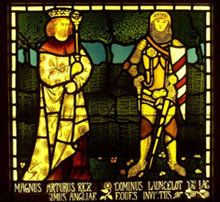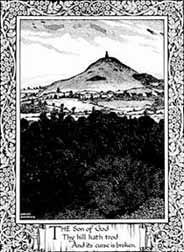|
Green Man Garden Services
Landscaping • Clearance • Hedge Trimming • Lawn Cutting • General Maintainance • All Aspects of Tree Work
For a Free Consultation call 01978 856343 stephen.goodwin17@btinternet.com
Click on the Green Man to visit our website!
 |
Chester:
A
Virtual
Stroll
Around
the
Walls
Melkin's Prophecy
by Steve Goodwin
On to Chapters 2 | 3 | 4 | 5 | 6 | 7 | 8 | 9 | 10 | Bibliography
| Author's note: The following is very much a 'work in progress' and many additions and corrections are in the course of preparation... |

 t is easy to get carried away when your study involves the search for the origins of Avalon. Yet, the line between ‘myth’ and ‘reality’ may become blurred when the subject is approached afresh. The following is the culmination of three years research into a much misunderstood element of early British history and how aspects of it relate to my local area. For the most part I have simply brought together work carried out over many centuries and given them a geographic twist in an attempt to unlock an ancient secret.
t is easy to get carried away when your study involves the search for the origins of Avalon. Yet, the line between ‘myth’ and ‘reality’ may become blurred when the subject is approached afresh. The following is the culmination of three years research into a much misunderstood element of early British history and how aspects of it relate to my local area. For the most part I have simply brought together work carried out over many centuries and given them a geographic twist in an attempt to unlock an ancient secret.
Other efforts to ‘decode’ the Grail story have foundered due to the fact that they rely on material written down over twelve hundred years after the events, by chroniclers with one eye on the events of the day. With that in mind, I have attempted to approach the subject from an earlier perspective in an endeavour to shed light on the origins of what later became known as Avalon. The main distinction between this interpretation, and the alternatives, is that when the final page is turned you will have been presented with evidence and a location that deserves further archaeological investigation. Furthermore, if the findings are generally correct, a sacred ‘can of worms’ will open revealing the light and dark side of our spiritual past, and by chance, an ancient prophecy will be fulfilled.
In 1343 John of Glastonbury completed his history of the Glastonbury church. Within this text was an element called the Prophecy of Melkin, an ancient riddle that, when solved, claims to reveal the lost burial site of the biblical character Joseph of Arimathea. There is evidence that suggests that the prophecy was written by a monk call Melchinus or Melkin some time in the 6th century. Melkin is described as ‘a writer and seer’ within the Celtic Christian tradition by historians throughout the medieval era. Furthermore, late medieval writers saw Melkin as one of the very few reliable sources of this period. One of these, Leyand (c.1535), claims to have seen the original text of the prophecy in the library of Glastonbury Abbey and describes the  manuscript as being of ‘great antiquity’. Others, such as Bale and Capgrave, credit Melkin with writing of manuscripts and of being highly skilled in both geometry and astrology. Melkin appears in every major historical work up until the mid 18th century and then is dropped as fashions and historical perspective seek a more ‘rational’ approach to what was perceived as legitimate historical sources. It was finally translated from Latin into English in the 1920’s, when the translator describes the text as “a queer piece of semi-poetic prose, intended to mystify and hardy capable of translation into English” (A. Robinson; 1926).
manuscript as being of ‘great antiquity’. Others, such as Bale and Capgrave, credit Melkin with writing of manuscripts and of being highly skilled in both geometry and astrology. Melkin appears in every major historical work up until the mid 18th century and then is dropped as fashions and historical perspective seek a more ‘rational’ approach to what was perceived as legitimate historical sources. It was finally translated from Latin into English in the 1920’s, when the translator describes the text as “a queer piece of semi-poetic prose, intended to mystify and hardy capable of translation into English” (A. Robinson; 1926).
The Latin text that has come down to us contains passages that defy exact translation and any explanation is fraught with difficulty and ambiguity. This has lead many commentators to the conclusion that the so called prophecy is nothing more than an elaborate 14th century forgery. However, one of leading commentators on the subject concludes that: “Melkin’s prophecy is an example of a highly esoteric text laced with occult information, and that it contains hints of a consciously coded secret which by the time of John of Glastonbury had become altogether garbled.” (Prof. J. Carley: 1981: p 12-13). When this enigmatic series of prose is reassessed it becomes apparent that it is our perception of the story’s original geography that is questionable and not the text. Geoffrey Ashe, recognised the antiquity of the document and was aware that it did not originate in Glastonbury. He states that “the prophecy looks as if it might well embody something handed down from the Celtic era by way of Wales”(Ashe; 1960)
As mentioned above the text makes reference to Joseph of Arimathea, spoken of in the Gospels as “Jesus’ disciple”, member of the Jewish Council and the rich merchant who went to Pilate after the crucifixion and placed the body of Jesus in his own tomb. According to tradition, following the execution of Jesus, Joseph fled to France and later Britain, as then the very edge of the known world. Later, writers claim that Joseph spent the final part of his life in Britain and it has been generally acknowledged that his place of burial was Glastonbury. Subsequently, any attempt to solve the clues set out in the prophecy has remained fruitless to this day. Yet, their failure may merely be due to a misunderstanding of the original location of, what the Romances call, “Avalon”. However before we go in search of the original Avalon we must first consider the so called ‘Prophecy’. John of Glastonbury sets the scene:
“The chief personages of the country would rather await the day of resurrection in the monastery…in the protection of Mary the ever-virgin Mother of God, than any where else…Therefore a certain soothsayer of the Britons, Melkin by name, thus began his prophecy.”
‘The Isle of Avalon, with avidity claims the death of pagans
More than all the world beside, for the entombment of them all,
Decorated beyond all others by the chanting spheres of prophecy.
And for all time to come adorned shall it be by them that praise the Most High.
Abbadare mighty in saphat, noblest of pagans, has fallen on sleep with 104,000 other
Among these Joseph of Arimathea hath found perpetual sleep in a marble tomb,
And he lies on a forked line next to the southern corner of an oratory,
Where the wattle is prepared above the mighty maiden and where the 13 spheres rest
For Joseph has with him in his sarcophagus 2 white and silver vessels,
Filled with the blood and sweat of the prophet Jesus.
When his sarcophagus is discovered, it will be seen whole and undecayed,
And will be opened to the whole world.
Thenceforth those who dwell in that noble isle will lack
Neither water nor the dew of heaven.
For a long while before the day of judgment in Josaphat
Open shall these things be and declared to the living.’
On to part II
Site Front Door | Site Index | Chester:
A Virtual Stroll Around the Walls
The Black & White Picture Place | Readers Letters | Links
|
The Black & White Picture Place
Original photography for all occasions. Click on the camera to find out more |
![]()


 t is easy to get carried away when your study involves the search for the origins of Avalon. Yet, the line between ‘myth’ and ‘reality’ may become blurred when the subject is approached afresh. The following is the culmination of three years research into a much misunderstood element of early British history and how aspects of it relate to my local area. For the most part I have simply brought together work carried out over many centuries and given them a geographic twist in an attempt to unlock an ancient secret.
t is easy to get carried away when your study involves the search for the origins of Avalon. Yet, the line between ‘myth’ and ‘reality’ may become blurred when the subject is approached afresh. The following is the culmination of three years research into a much misunderstood element of early British history and how aspects of it relate to my local area. For the most part I have simply brought together work carried out over many centuries and given them a geographic twist in an attempt to unlock an ancient secret.  manuscript as being of ‘great antiquity’. Others, such as Bale and Capgrave, credit Melkin with writing of manuscripts and of being highly skilled in both geometry and astrology. Melkin appears in every major historical work up until the mid 18th century and then is dropped as fashions and historical perspective seek a more ‘rational’ approach to what was perceived as legitimate historical sources. It was finally translated from Latin into English in the 1920’s, when the translator describes the text as “a queer piece of semi-poetic prose, intended to mystify and hardy capable of translation into English” (A. Robinson; 1926).
manuscript as being of ‘great antiquity’. Others, such as Bale and Capgrave, credit Melkin with writing of manuscripts and of being highly skilled in both geometry and astrology. Melkin appears in every major historical work up until the mid 18th century and then is dropped as fashions and historical perspective seek a more ‘rational’ approach to what was perceived as legitimate historical sources. It was finally translated from Latin into English in the 1920’s, when the translator describes the text as “a queer piece of semi-poetic prose, intended to mystify and hardy capable of translation into English” (A. Robinson; 1926).